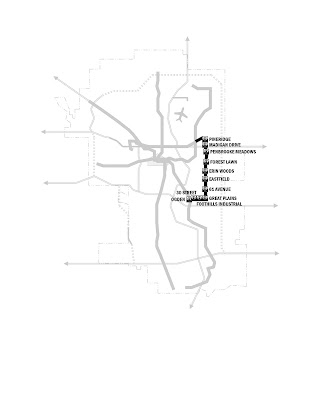
Phase II of Line 204 would extend from Rundle Station in a generally east-by-northeast direction for roughly 1,400 metres before curving to the southeast and south for another 200 metres before surfacing in a streetside right of way along 52 Street NE and arriving at Pineridge Station, where 52 Street intersects 26 Avenue NE. From there, the service would continue on the surface adjacent to 52 Street NE, travelling 1,600 metres to Madigan Drive Station and a further 1,500 metres to Penbrooke Meadows Station, at the intersection with Fifth Avenue SE, before proceeding 1,100 metres south to descend through an underground portal to arrive 200 metres due south at Forest Lawn Station, an underground metro station beneath the junction of 52 Street and 17 Avenue SE. The line would continue 200 metres south before surfacing and proceeding a further 1,400 metres at grade along 52 Street SE to arrive at Erin Woods Station, near 34 Avenue SE, and continuing south another 1,400 metres to Eastfield Station, at the intersection with 48 Avenue SE, and a further 1,300 metres to 61 Avenue Station, before covering an 1,100-metre distance to turn through an underground portal to a surface alignment at 72 Avenue SE and arrive at Great Plains Station. At that point, the line would continue westward 800 metres to Foothills Industrial Station, just west of 44 Street SE, and a further 900 metres to 30 Street Station before crossing the Western Headworks Canal and traversing the CPR Ogden Shops at a grade separation to terminate after a distance of 1,800 metres at an underground interchange with Ogden Station on Line 203.
The total capital investment required for the 52 Street Industrial phase of Line 204 comes to $987-million, a figure that could be carried over thirty years in instalments of $49-million from 2027 onward, or financed through an MSI-equivalent funding mechanism from 2024 to 2026 in three instalments of $329-million. The details of the necessary capital investment are identified as follows:
52 Street Industrial Metro Track and Way of 2.00 km
@ $155-million per km: $310-million
plus two metro stations (Forest Lawn, Ogden)
@ $92-million each: $184-million
The total capital investment required for the 52 Street Industrial phase of Line 204 comes to $987-million, a figure that could be carried over thirty years in instalments of $49-million from 2027 onward, or financed through an MSI-equivalent funding mechanism from 2024 to 2026 in three instalments of $329-million. The details of the necessary capital investment are identified as follows:
52 Street Industrial Metro Track and Way of 2.00 km
@ $155-million per km: $310-million
plus two metro stations (Forest Lawn, Ogden)
@ $92-million each: $184-million
52 Street Industrial Surface Track and Way of 11.00 km
@ $25-million per km: $275-million
plus nine surface stations (Pineridge, Madigan Drive, Penbrooke Meadows, Forest Lawn, Erin Woods, Eastfield, 61 Avenue, Great Plains, Foothills Industrial, 30 Street)
@ $10-million each: $ 90-million
Rolling Stock of 32 LRVs (Avanto)
@ $4-million each: $128-million
The second phase of Line 204 greatly increases the connectivity of residential neighbourhoods in eastern Calgary to commercial, residential, and institutional destinations throughout the city, but this is far from the only passenger mobility enhancement deriving from the installation of this new element of the C-Train system. As Roderick Diaz notes in “Impacts of Rail Transit on Property Values”, one key benefit of a light rail line serving an industrial corridor is that commercial and industrial sites located in proximity to mass transit services “experience higher property values because such properties have increased access to a larger labour market” (Diaz, 1999:4). This rise in city-wide labour mobility results in direct and ancillary benefits to industrial employers and to retail operators serving an enlarged labour pool, which as described in “The Calgary Transportation Effect” turns an increased and more efficient transit passenger throughput into “increased retail activities, expanding the attractiveness of the area to commercial investors and retailers” (Campbell et alia, 2007:9). Both of these effects anticipate the overall development and mobility strategy articulated in the “Southeast Industrial Area Structure Plan”, in which “demand for serviced industrial land can be met in an economical manner and in a manner that is responsive to changing market conditions” (City of Calgary, 1996:4). On multiple levels, therefore, using 52 Street E to define the eastern arc of Line 204 is a strategic transportation benefit to C-Train passengers; to residential, commercial, and industrial development in eastern Calgary; and to the city as a whole.
Works Cited
Campbell, Don R.; Reuter, Ray; and Tennant, Melanie (2007). “The Calgary
Transportation Effect: The Impact of Transportation Improvements on Housing Values in Greater Calgary”. URL as of 24 Mar 2008 http://www.realestateinvestingincanada.com/files/calgary_transportation_%20report.pdf
Transportation Effect: The Impact of Transportation Improvements on Housing Values in Greater Calgary”. URL as of 24 Mar 2008 http://www.realestateinvestingincanada.com/files/calgary_transportation_%20report.pdf
City of Calgary (1996) “Southeast Industrial Area Structure Plan”. URL as of 26 Mar 2008 http://www.calgary.ca/docgallery/bu/planning/pdf/southeast_industrial_asp/southeast_industrial_asp_one.pdf
Diaz, Roderick B. (1999). “Impacts of Rail Transit on Property Values”. URL as of 18 Jul 2008 http://www.apta.com/research/info/briefings/documents/diaz.pdf
No comments:
Post a Comment